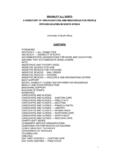Transcription of SLAVERY AND THE SLAVE TRADE IN PRE-COLONIAL AFRICA
1 Page 1 SLAVERY AND THE SLAVE TRADE IN PRE-COLONIAL AFRICA by Perbi Fulbright-Scholar-in-Residence Manchester College Indiana, delivered on 5th April 2001 at the Univ. of Illinois, and the SLAVE TRADE have been age old institutions and practices in almost everycontinent in the world. Orlando Patterson states: There is nothing notably peculiar about the institution of SLAVERY . It has existed from before the dawn of human history right down to the twentieth century, in the most primitive of human societies and in the most civilized.
2 There is no region on earth that has not at some time harbored the institution. Probably there is no group of people whose ancestors were not at one time slaves or SLAVE holders. SLAVERY was firmly established in all the great early centres of human civilization ( SLAVERY and Social Death-A Comparative Study, 1982, p. vii).The earliest known legal documents concerned not the sale of land, houses, animals, boatsand such like, but the sale of slaves. In Mesopotamia for example, the sale of slaves wasknown from 2300 ( A SLAVERY in Time and Space@, J. Goody, in Asian and AfricanSystems of SLAVERY , Ed. by Watson, Berkeley & Los Angeles 1980, ).Scholars cannot agree on the reasons for the rise of SLAVERY .
3 Some believe that the needfor labor, especially agriculture gave rise to SLAVERY . Others believe that political reasonsgave rise to SLAVERY , and yet others postulate that commerce gave rise to general belief held by Historians and Anthropologists is that SLAVERY was notPage 2important when Humankind depended on food gathering, hunting and fishing, thebasic economy in the first stage of human evolution. Goody, however cautions that evenamong hunters and gatherers there were exceptional instances where SLAVERY occurred,and he cites the example of the North West coast of America( Goody, Time & Space, p. 26).From North to South, and from East to West, the African continent became intimatelyconnected with SLAVERY both as one of the principal areas in the world where SLAVERY wascommon, and also as a major source of slaves for ancient civilization, the medieval worldand all the continents of the modern period.
4 The greatest African community in theDiaspora is believed to be in Brazil with a population of about 200 million, followed bythe Carribean and the North AFRICA SLAVERY was practiced in the Sahara desert and its southern border lands,as well as in the region of modern western Sahara, Morocco and Algeria among theBerbers. In the Central Sahara and in the sub desert areas further south, the Tuaregspracticed SLAVERY . In North East AFRICA , the Ethiopians, Somalis, Egyptians and thepeople of the Sudan were all familiar with the institution of SLAVERY . In West Africaslavery was known among many of the states and societies. For example among theWolof and Serer of Senegambia, the Mende and Temne of Sierra Leone, the Vai ofLiberia and Sierra Leone, and virtually all the states and societies in Guinea, Ghana, IvoryCoast, Dahomey, Mali, Nigeria etc. In Central AFRICA SLAVERY was practiced in much ofBantu AFRICA for example among the Duala of Cameroon; the Bakongo, Bapende Lubaand Lunda of Zaire ( now the Democratic Republic of the Congo), Congo and part ofAngola, and the Lozi of Zambia.
5 In East AFRICA the Buganda state, the Nyamwezi and theChagga peoples practiced SLAVERY . Along the coast, the Mrima Arabs, Omani Arabs andthe ASawahilis@ practiced SLAVERY . In Southern AFRICA the Cokwe of Angola, the Sena ofMozambique and the Ngoni people scattered across East, Central and Southern Africawere all familiar with the institution of dimensions to SLAVERY and the SLAVE TradeThere were two dimensions to SLAVERY and the SLAVE TRADE in PRE-COLONIAL AFRICA , anexternal and internal dimension. The external dimension involved TRADE across theSahara, the Mediterranean, the Red Sea, the Arabic and Indian ocean worlds. This tradebegan in ancient times and continued into the modern period. Ancient Egypt, Greece andRome used African slaves. Medieval Europe and the Arabic and Islamic world, and thecontinent of Asia made use of African slaves.
6 On the islands of the EasternMediterranean African slaves could be found working with slaves from Asia Minor,Greece, the Balkans, Eastern and Northern 3In the early modern period the picture was very much the same. What I find interesting inthe ancient, medieval and early modern period is the existence of not only black and whiteslaves working together but also the prevelance of three main forms of labor not limitedto color, SLAVE labor, indentured labor and 1453 the Ottoman capture of Constantinople halted the flow of white slaves from theBlack Sea region and the Balkans. Mediterranean Europe was thus cut off from one of itstraditional source of slaves. Mediterranean Europe turned completely to AFRICA for slavelabor ( A History of World Societies, 3rd Ed., Mckay, Hill & Bucklar, 1992, ).The last phase of the external TRADE was that which involved the Oriental, Islamic andAtlantic worlds during the 15th to the 19th centuries.
7 Suzanne Miers relates that thefunction of SLAVERY in the Islamic world was both social and economic, and that themarket was selective and sophisticated. The most highly prized were not Africans but thewhite slaves usually Circassian or Georgian girls. They were wanted as concubines inHarems as far apart as Zanzibar and Morocco in AFRICA , but they were expensive and thenumbers small. In Arabia, Ethiopian men cost more than the Ablack@ men of Africabecause they were considered more refined and intelligent and less suited to heavy work. The desert nomads and the employers of heavy labor, however, wanted A hardy There was a market in Arabia for black slaves from as far afield as modern Malawi inAfrica ( Britain and the Ending of the SLAVE TRADE , S. Miers, London 1975, p. 56-58).The internal TRADE was conducted within the African continent itself. It involved tradebetween North AFRICA and West AFRICA on the one hand and East, Central and SouthernAfrica on the other hand.
8 My country Ghana, formerly called the Gold Coast becameimportant in the TRADE with other West African states and with North AFRICA because of itsrichness in gold. Daaku relates that the Akan of Ghana were drawn into the main streamof developments in the TRADE across the Sahara to North AFRICA because the Offin and thePra river basins where they were concentrated in large numbers were rich in gold ( Tradeand Politics on the Gold Coast 1600-1720, Daaku, Great Britain 1970, p. 3). Archaeological evidence indicates that the ancient gold mining areas in Ghana were atJinjini and Chemraso in modern Dormaa Ahenkro; Nsuhunu, Banda Nkwanta, Jenikrom,Awusu and Atuna in the modern Takyiman area and a number of Adanse villages andtowns such as Kenyasi, Jameskrom and Jeda ( Rediscovering Ghana=s Past, J. Anquandah,Great Britain, 1982, ).Bono Manso and Begho in modern Brong Ahafo region became important centers for thistrade from 1000 to 1750 The Mande Dyula were the professional merchants in thisPage 4trade.
9 The West African forest region supplied gold, kola nuts, ivory and slaves in thistrade. Ghana though in the forest region was known to have supplied gold, kola nuts andivory. The West African savanna region provided millet, sorghum, wheat, livestock,gum, shea butter, ivory, ostrich feathers, cloth, gold and slaves. The Sahara contributedsalt, copper, tobacco and dates. From Europe and the Muslim world came textiles andgarments made from wool, silk, brocade, velvet or satin; calicoes, metals such as brass,copper, silver, tin and lead. Other goods from the Mediterranean world were books,writing paper, cowries, tea, coffee, sugar, spices, jewellry, perfumes, bracelets, mirrors,carpets, beads etc. Ghana obtained slaves through this TRADE from the 1st to the 16thcenturies the West African states along the Atlantic coast were linked by a southern TRADE routecovering modern Senegal to modern Nigeria.
10 Ghana, again because of its wealth in gold,exchanged gold for slaves, beads, cotton, cloth and palm oil from the Benin state inmodern Nigeria. From Dahomey and Ivory Coast, Ghana exchanged gold for the famousA quaqua@ cloth. Shama on the Ghana coast was the entrepot of the first Europeans the Portuguese set foot on the shores of Ghana in 1471, theyfound in existence a brisk TRADE in slaves and other goods between Ghana and its coastalneighbors, it took part in the TRADE and for 100 years was the only European countrytrading directly with Ghana and its coastal neighbors. In 1479 Eustache de la Fossestated that he bought slaves from the Grain Coast for sale at Shama. Pacheco Pereirareported that because the kingdom of Benin in modern Nigeria was usually at war with itsneighbors it possessed many captives. The slaves were brought to Ghana and exchangedfor gold ( Esmeraldo de Situ Orbis, D.)



